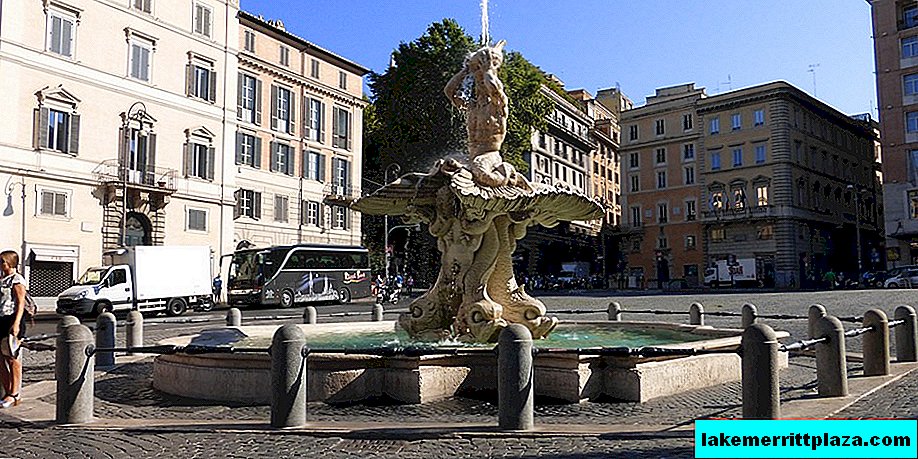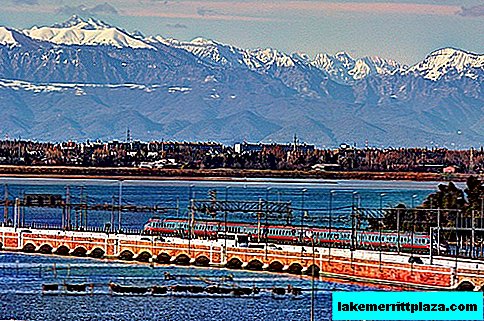Piazza Barberini is a landmark in central Rome. The name is given to the square named after the ancient Roman genus Barberini.
History of the square
In ancient times, the site of the current square housed the temple of the goddess Flora, next to which noisy popular holidays were celebrated in honor of the arrival of spring.
Then, at the beginning of the 16th century, a square was built here and named after the name of Cardinal Grimani, in 1625 it was renamed by the name of the noble Milanese family Sforza. The estate of Sforza was acquired by Maffeo Barberini, the future pope Urban VIII (Urbanus PP. VIII), in 1627 decided to build a palazzo here.

Pope Urban VIII is a distinguished figure of his time, educated and well-read, who had a large collection of books at that time, familiar with Galileo Galilei, who patronized the arts. He was the initiator of the construction of many buildings in Rome, and the palace and square were intended to perpetuate his glorious family.
Thus, the square acquired its name in 1633, when the Barberini Palace majestically ascended from its southern side, on a hill, and gardens were laid out around the square.
In the middle of the XVII century, under the leadership of the architect and sculptor Giovanni Lorenzo Bernini, a theater of the same name was built on the square. This building has become the cultural center of the city: representatives of science and art came here, theater performances, musical evenings, balls were arranged, poets read their works. The theater lasted until 1873, and then was demolished for the construction of Via Barberini.
However, in the history of Rome, after the construction of the palace, the square was associated with such a sad ceremony as the identification of the unknown dead inhabitants of the city. From the time of construction until the XVIII century, a cart with unidentified dead men drove away from the square, passed through all the streets of the city, where residents could identify their relatives.
According to the plan of the pontiff Urban VIII, the square was supposed to be a harmonious ensemble with the Barberini Palace, so the Fountains known all over the world - Triton and Bees, representing the symbolism of an ancient and glorious family were built on it.
- See also: the most beautiful squares of Rome
Triton Fountain

The Triton Fountain (Fontana del Tritone) was built by the architect Bernini in 1642 at the direction of Pontiff Urban VIII and was to make an ensemble with the Barberini Palace, the construction of which was completed shortly before.
As a building stone, the local travertine stone, popular in ancient times, was used, plastic and superbly machinable, allowing you to finely perform the most miniature details. And the water was brought to the fountain from the restored ancient Roman aqueduct Aqua Felice (Acqua Felice).
The fountain was different from all built earlier in Rome and by Bernini himself. The sculptural group appeared as an illustration to a fragment of Ovid's poem "Metamorphoses", which describes the son of the god Poseidon and the river deity Amphitrite, the hero Triton, blowing water out of a sink.
The entire sculptural group is non-traditional, the master refused the image of the classic bowls set on top of each other.
The fountain represents a new direction in art - baroque. All elements of the sculptural group have a complex shape, the author skillfully conveyed the movement of the heroes of the composition, the dynamics of water flows.
The base of the sculptural group is 4 dolphins standing on their heads with open mouths and lifting up curved tails. The image of the sea deity of Triton stands on a huge open shell supported by dolphin tails. The half-human half-fish with a powerful tail resting on the sink holds another horn shell in its hands and as if throws a strong water stream through it falling into the fountain.
During construction, the jet was high and created significant noise in the area, so the fountain was called Roaring Triton.
Residents loved the fountain very much, since they considered the water in it to be a gift of the sea god, and therefore possessing magical properties: water should give peace and harmony.
Bees on the arms of Barberini

Among the elements of the sculptural ensemble in the center are the tiara of the Pope and the coat of arms of the genus Barberini with three bees sitting on it. An interesting detail of the coat of arms of the genus is bees, symbolizing the love of representatives of this family for work and family, as well as singing the talent and selfless skill of a person.
The appearance of bees on the coat of arms of the genus Barberini is associated with an ancient legend. The ancient family was known in Florence since the XI century as a wealthy and close to the ruling circles. When the heir fell ill in the family, all the famous doctors were convened, but could not help him. By chance, a poor man who collected wild honey from wild bees found out about this grief and, using bee venom and tinctures of herbs on honey, healed the patient. As soon as the boy got better, the honey collector disappeared without giving his name and without requiring a reward. In gratitude, a decision was made from then on to place a bee on the coat of arms of the family - a symbol of labor and healing.
Pope Urban did not find it enough to complete the architectural ensemble of the square of one fountain, and he ordered Bernini another fountain. So the Bees Fountain appeared.
Bees Fountain

The Fountain of Bees (Fontana delle Api) appeared two years after the Fountain of Triton, in 1644, but located not in the center, but on the corner of the square, and at the beginning of Via Felice, and in 1800 it was moved to the corner of Via Vittorio Veneto and Via di San Basilio. The author is, of course, Bernini, a favorite of Urban VIII.
This light and elegant fountain is made in the shape of a small open shell, at the base of which three bees sit, filling it with pure water.
Water from the fountain runs into the lower shell of the sink. The name of Pope Urban VIII is written on the top of the shell. As the basis for the sculptural group, the author chose simple unprocessed stones, which create a vivid contrast with the craftsman's skillful filigree work when making shells and figurines of bees.
The inscription included the handwritten couplet of Urban VIII (patron Bernini), indicating that then was the 22nd year of his reign.
- Interesting fact: the date in the end had to be corrected, since dad died 8 days before the expiration of the 22nd year after his election - a unit was taken away from the original figure XXII.

The miniature and original Bee Fountain celebrates the work of the bee and its help to people and is an important ideological element of the square.
The fountain is surrounded by plane trees, tourists relax and drink clean water from the fountain in their shade, and the marvelous legends of the Barberini house give room for reflection on human life.
How to get there
Piazza Barberini can be reached by metro (line A). Right under the square is Barberini Station, and a five-minute walk to famous attractions - the Trevi Fountain and the Spanish Steps.








